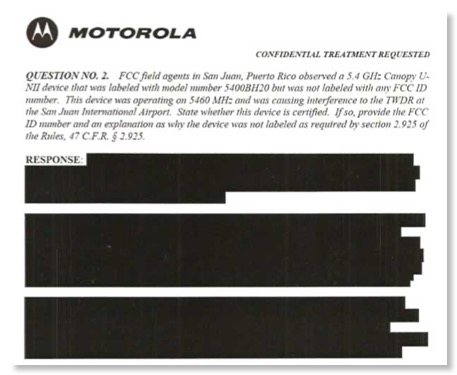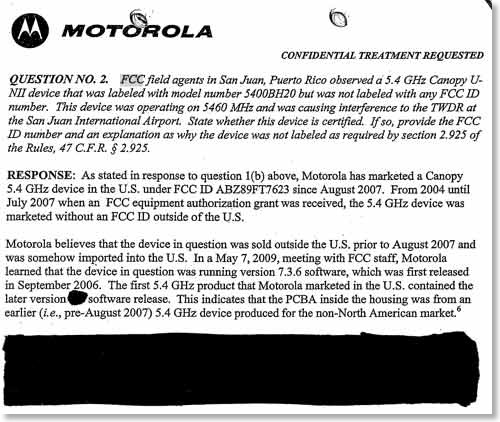"Michael Marcus, P.I." - FHH Current Issues in Telecommunications Law and Regulation

My friends at FHH CommLawBlog have written the above article in the December 2012 Current Issues in Telecommunications Law and Regulation, a newsletter based on the blog. (Apparently FHH has a law practice as a sideline to blogging. Blogging is really a lot more fun!)
The article deals with my FOIA request at FCC to get to the bottom of the U-NII interference to safety-related NOAA TDWR weather radars near airports. This resulted in a “reverse FOIA” action by Motorola seeking to limit the release of information for what was said to be protection of proprietary information but which appeared to be based in some part on just preventing embarrassment.
Original Motorola Redaction Initially Upheld by FCC Staff

Redaction After FCC 9/12 Order

FCC ultimately upheld part of your blogger’s request giving Motorola the type of defeat that used to be very rare for them when they dominated (monopolized?) the mobile radio biz.
Here’s part of what FHH wrote:
In our recent blog post on our CommLawBlog site about an AT&T wireless Internet service causing interference to an airport weather radar in Puerto Rico, we asked whether the FCC had charged AT&T with the wrong offense. Because the transmitter operated outside its FCC- certified frequency range (among other problems), the FCC determined it did not qualify for unlicensed operation, and so fined AT&T for not having a license – even though AT&T could not have obtained a license for that service.
Our friend Michael Marcus, a spectrum-savvy engineer (and former FCC official), asked a different question: how did the transmitter get to be operating on a non-certified frequency? Where most of us would be content to mull this over in our idle hours (if it occurred to us at all), Marcus is made of different stuff. He not only took the question to the highest reaches of the FCC, but managed to get some answers.
The article goes on to say
Marcus appealed that decision to the full Commission, ask- ing for access to specific redacted information. He argued, in part, that release of the information is in the public interest because it may shed light on the root causes of interference from the Canopy transmitters into airport radars, and thus promote air safety. The FCC’s decision gave Marcus a partial victory.
Thanks to FHH for the free press.



![Validate my RSS feed [Valid RSS]](valid-rss-rogers.png)

